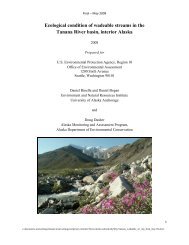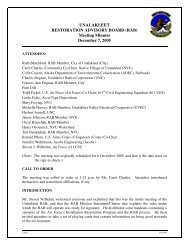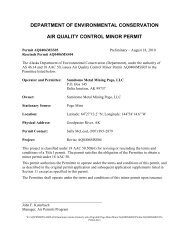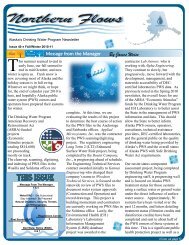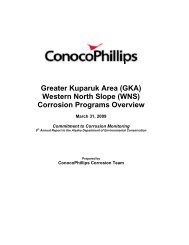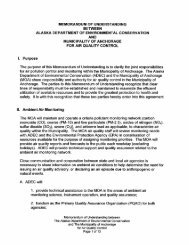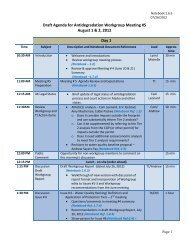2012 Ocean Ranger Guidebook Revision 3-7-12 - Alaska ...
2012 Ocean Ranger Guidebook Revision 3-7-12 - Alaska ...
2012 Ocean Ranger Guidebook Revision 3-7-12 - Alaska ...
You also want an ePaper? Increase the reach of your titles
YUMPU automatically turns print PDFs into web optimized ePapers that Google loves.
<strong>20<strong>12</strong></strong> <strong>Ocean</strong> <strong>Ranger</strong> <strong>Guidebook</strong> 3-7-<strong>12</strong><br />
tank alarms recorded? Is telephone / communication system from deck (bunkerstation) to other parts of<br />
the system (manifold) in place? Are general operation procedures in place?<br />
Job Aid Item: 7.1.g<br />
Text: Vessel OWS related vessel machinery logs, reports for maintenance, repairs, cleaning operations<br />
(e.g. back flush) onboard and available.(33 CFR 151.10 b)<br />
Background: OWS logs in general tells what the equipment status is with regard the maintenance,<br />
repairs and general technical status of the equipment.<br />
What to check for: Is the OWS operable? When was the last calibration done? What is the last regular<br />
maintence action? By whom were these maintenance actions performed? Are maintence repair<br />
calibration reports available?<br />
Subsection 2: Oil Pollution; Fuel; Oily Water Separators (OWS), General (33<br />
CFR 155.360/370, 33 CFR 151.10);<br />
Note: Citations can be found under the general citations in this section, unless specific to that item then<br />
they are listed with the item.<br />
Job Aid Item: 7.2.a<br />
Text: Check for recent paint on pipe segments, or other changes. (33 CFR 151.10)<br />
Background: Historically some vessels “by passed” the OWS systems and conducted “direct discharges”.<br />
Changes or alterations of piping are possible indicators that “magic piping” is done and the OWS was not<br />
used for oily water discharges. There are more in-depth checks on this in the seasonal report. This item<br />
is meant as an update to the seasonal in-depth checks, to see if any changes have been made since then.<br />
The seasonal report could be a useful reference for this.<br />
What to check for: OWS status in general. Scraped nuts bolts head, missing washers and fresh fixed<br />
piping are suspect. Also blind flanges, connectors and hoses are possible indicators of non original (as<br />
built) OWS discharge piping lay out. Compare the system with as built drawing and trace the piping. Ask<br />
questions, communicate. New pipe sections, flexible sections and blind flanges / spectacles are suspect.<br />
Job Aid Item: 7.2.b<br />
Text: If in use, observe that OWS unit is processing from contaminated source. (33 CFR 151.10)<br />
Background: The OWS is used to process “oily water” and bilge water. Vessels that burn oil will have<br />
oily sludges, and produce sludge. In order to make sure that the oily wastes are discharged correctly an<br />
OWS system must be used and operable.<br />
What to check for: Operable OWS system including associated systems, tanks etc. Familiarize with the<br />
entire system and how the system is operated. Checks for OWS piping, storage tanks and how the<br />
“influent” is processed and originated from.<br />
Job Aid Item: 7.2.c<br />
Text: Checked for similar readings of oil content meters (units with multiple oil content meters)(33<br />
CFR 151.10)<br />
209






